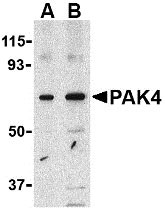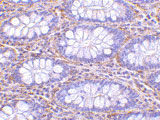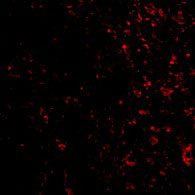PAK4 Antibody
- 产品详情
- 实验流程
- 背景知识
Application
| WB, IF, E, IHC-P |
|---|---|
| Primary Accession | O96013 |
| Other Accession | NP_005875, 5031975 |
| Reactivity | Human |
| Host | Rabbit |
| Clonality | Polyclonal |
| Isotype | IgG |
| Calculated MW | 64072 Da |
| Concentration (mg/ml) | 1 mg/mL |
| Conjugate | Unconjugated |
| Application Notes | PAK4 antibody can be used for the detection of PAK4 by Western blot at 1 - 2 µg/mL. Antibody can also be used for immunohistochemistry starting at 10 µg/mL. For immunofluorescence start at 20 µg/mL. |
| Gene ID | 10298 |
|---|---|
| Other Names | PAK4 Antibody: KIAA1142, p21-activated kinase 4, PAK-4, p21 protein (Cdc42/Rac)-activated kinase 4 |
| Target/Specificity | PAK4; PAK4 antibody is predicted to not cross-react with other PAK family proteins. |
| Reconstitution & Storage | PAK4 antibody can be stored at 4℃ for three months and -20℃, stable for up to one year. As with all antibodies care should be taken to avoid repeated freeze thaw cycles. Antibodies should not be exposed to prolonged high temperatures. |
| Precautions | PAK4 Antibody is for research use only and not for use in diagnostic or therapeutic procedures. |
| Name | PAK4 (HGNC:16059) |
|---|---|
| Synonyms | KIAA1142 |
| Function | Serine/threonine-protein kinase that plays a role in a variety of different signaling pathways including cytoskeleton regulation, cell adhesion turnover, cell migration, growth, proliferation or cell survival (PubMed:26598620). Activation by various effectors including growth factor receptors or active CDC42 and RAC1 results in a conformational change and a subsequent autophosphorylation on several serine and/or threonine residues. Phosphorylates and inactivates the protein phosphatase SSH1, leading to increased inhibitory phosphorylation of the actin binding/depolymerizing factor cofilin. Decreased cofilin activity may lead to stabilization of actin filaments. Phosphorylates LIMK1, a kinase that also inhibits the activity of cofilin. Phosphorylates integrin beta5/ITGB5 and thus regulates cell motility. Phosphorylates ARHGEF2 and activates the downstream target RHOA that plays a role in the regulation of assembly of focal adhesions and actin stress fibers. Stimulates cell survival by phosphorylating the BCL2 antagonist of cell death BAD. Alternatively, inhibits apoptosis by preventing caspase-8 binding to death domain receptors in a kinase independent manner. Plays a role in cell-cycle progression by controlling levels of the cell-cycle regulatory protein CDKN1A and by phosphorylating RAN. Promotes kinase-independent stabilization of RHOU, thereby contributing to focal adhesion disassembly during cell migration (PubMed:26598620). |
| Cellular Location | Cytoplasm. Note=Seems to shuttle between cytoplasmic compartments depending on the activating effector. For example, can be found on the cell periphery after activation of growth-factor or integrin-mediated signaling pathways. |
| Tissue Location | Highest expression in prostate, testis and colon. |
For Research Use Only. Not For Use In Diagnostic Procedures.
Provided below are standard protocols that you may find useful for product applications.
BACKGROUND
PAK4 Antibody: The p21-activated kinases (PAKs) are serine-threonine kinases that bind to the active forms of Cdc42 and Rac. They are divided into two groups, the first of which include PAK1, 2 and 3, and can be activated by Cdc42/Rac binding. Group 1 PAKs contain an autoinhibitory domain whose activity is regulated by Cdc42/Rac binding. The group 1 PAKs are known to be involved in cellular processes such as gene transcription, apoptosis, and cell morphology and motility. Much less is known about the second group, which includes PAK4, 5 and 6. These proteins are not activated by Cdc42/Rac binding. PAK4 was initially identified as a novel effector of Cdc42Hs. Co-expression of PAK4 and Cdc42Hs resulted in induction of filopodia and actin polymerization, showing that it is involved in cytoskeletal reorganization. Other experiments have shown PAK4 to be essential for embryonic viability and proper neuronal development. PAK4 has also been implicated in anchorage-independent growth of tumor cells and is required for activation of several cancer prosurvival pathways.
REFERENCES
Jaffer ZM and Chernoff J. p21-activated kinases: three more join the Pak. Int. J. Biochem. Cell Biol. 2002; 34:713-7.
Abo A, Qu J, Cammarano MS, et al. PAK4, a novel effector for Cdc42Hs, is implicated in the reorganization of the actin cytoskeleton and in the formation of filopodia. EMBO J. 1998; 17:6527-40.
Cotteret S, Jaffer ZM, Beeser A, et al. p21-activated kinase 5 (Pak5) localizes to mitochondria and inhibits apoptosis by phosphorylated BAD. Mol. Cell. Biol. 2003; 23:5526-39.
终于等到您。ABCEPTA(百远生物)抗体产品。
点击下方“我要评价 ”按钮提交您的反馈信息,您的反馈和评价是我们最宝贵的财富之一,
我们将在1-3个工作日内处理您的反馈信息。
如有疑问,联系:0512-88856768 tech-china@abcepta.com.























 癌症的基本特征包括细胞增殖、血管生成、迁移、凋亡逃避机制和细胞永生等。找到癌症发生过程中这些通路的关键标记物和对应的抗体用于检测至关重要。
癌症的基本特征包括细胞增殖、血管生成、迁移、凋亡逃避机制和细胞永生等。找到癌症发生过程中这些通路的关键标记物和对应的抗体用于检测至关重要。 为您推荐一个泛素化位点预测神器——泛素化分析工具,可以为您的蛋白的泛素化位点作出预测和评分。
为您推荐一个泛素化位点预测神器——泛素化分析工具,可以为您的蛋白的泛素化位点作出预测和评分。 细胞自噬受体图形绘图工具为你的蛋白的细胞受体结合位点作出预测和评分,识别结合到自噬通路中的蛋白是非常重要的,便于让我们理解自噬在正常生理、病理过程中的作用,如发育、细胞分化、神经退化性疾病、压力条件下、感染和癌症。
细胞自噬受体图形绘图工具为你的蛋白的细胞受体结合位点作出预测和评分,识别结合到自噬通路中的蛋白是非常重要的,便于让我们理解自噬在正常生理、病理过程中的作用,如发育、细胞分化、神经退化性疾病、压力条件下、感染和癌症。








